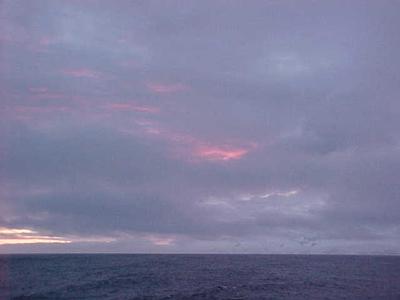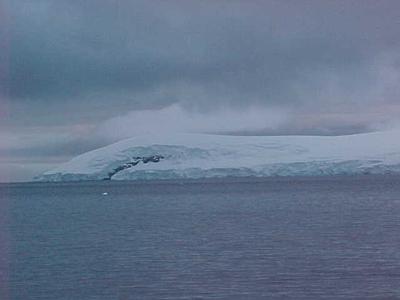7 March, 2000
Drake Passage; Circumpolar Current; First sight of Antarctic Peninsula
Question 17: How do penguins incubate their eggs?
The Gould is about three-quarters of the way to our destination. This
evening we will pass through some of the islands of the Antarctic Peninsula
and make our way in the more sheltered channels. Now we are moving south
through the West Wind Drift, a broad band of strong current that flows from
west to east around the Antarctic continent. It is "circumpolar" and is also
called the Antarctic Circumpolar Current. In places this current is several
thousand kilometers wide, but in the Drake Passage (where we are) it is
squeezed to about 900 kilometers between Cape Horn and the tip of the
Antarctic Peninsula. The West Wind Drift is irregular in both its width and
its exact course. It extends north beyond the Antarctic Convergence and south
to about 65 degrees south latitude. It is the world's largest ocean current
and flows at a rate of 153 million cubic meters per second, approximately a
thousand times the output of the Amazon River. The drift and the westerly
winds that drive it are unbroken by a large landmass as they continually
circle the continent, so huge waves and gale-force winds frequently develop.
This has been known to sailors as a rough and windswept ocean for hundreds of
years. The terms "roaring forties," "furious fifties" and "screaming sixties"
refer to conditions often found in these latitudes.
Last night one of the engines blew a gasket head and we were operating on
only one engine. The Chief Engineer was up the entire night cooling the
engine down (it took about 8 hours) and repairing it. Sometime today we
should be back near full power. The seas are around 12-18 feet, and fewer
people are up and about. Other than quick forays to stuff down a meal, I am
spending the day lying on a couch watching movies, and I haven't gotten
violently ill yet.
Just at sunset we sighted land!!! We can see Antarctica. Smith Island on
our starboard side is stunning--covered with glaciers and with a pink sky
behind it! We are also rolling less which is very important!
Answer 16: The wingspan (measurement from wingtip to wingtip) of a Wandering
Albatross is 3.5-4 meters.

Mountains of Smith Island.

First land!

Smith Island.

Contact the TEA in the field at
.
If you cannot connect through your browser, copy the
TEA's e-mail address in the "To:" line of
your favorite e-mail package.
|
